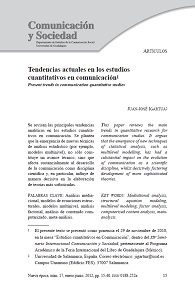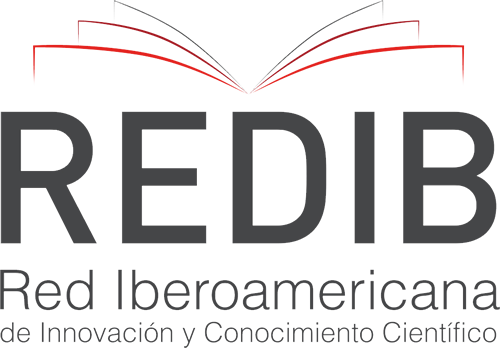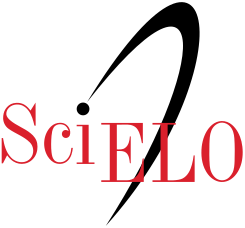Tendencias actuales en los estudios cuantitativos en comunicación
DOI:
https://doi.org/10.32870/cys.v0i17.273Palabras clave:
Análisis mediacional, modelos de ecuaciones estructurales, modelos multinivel, análisis factorial, análisis de contenido computarizado, meta-análisisResumen
Se revisan las principales tendencias analíticas en los estudios cuantitativos en comunicación. Se plantea que la emergencia de nuevas técnicas de análisis estadístico (por ejemplo, modelos multinivel), no sólo constituye un avance técnico, sino que afecta sustancialmente al desarrollo de la comunicación como disciplina científica y, en particular, influye de manera decisiva en la elaboración de teorías más sofisticadas.Descargas
Citas
Allen, M. & Preiss, R. W. (2007). Media, messages and meta-analysis. En R. W. Preiss, B. M. Gayle, N. Burrell, M. Allen & J. Bryant (Eds.), Mass media effects research. Advances through meta-analysis (pp. 15-30). Mawah, NJ, EE.UU.: Lawrence Erlbaum Associates
Anderson, C. A. (2004). An update on the effects of playing violent video games. Journal of Adolescence, 27, 113-122.
Baron, R. M. & Kenny, D. A. (1986). The moderator-mediator variable distinction in social psychological research: Conceptual, strategic and statistical considerations. Journal of Personality and Social Psychology, 51 (6), 1173-1182.
Boster, F. J. (2002). On making progress in communication science. Human Communication Research, 28 (4), 473-490.
Bryant, J. & Miron, D. (2004). Theory and research in mass communication. Journal of Communication, 54 (4), 662-704.
Bryant, J. & Thompson, S. (2002). Fundamentals of media effects.Nueva York, EE.UU.: McGraw-Hill.
Busselle, R. & Bilandzic, H. (2009). Measuring narrative engagement. Media Psychology, 12 (4), 321-347.
Cappella, J. N. (1975). An introduction to the literature of causal modeling. Human Communication Research, 1 (4), 362-377.
Cohen, J. (2002). Deconstructing Ally: Explaining viewers’ interpretations of popular television. Media Psychology, 4 (3), 253-277.
Dominick, J. & Wimmer, R. (2003). Training the next generation of media researchers. Mass communication and society, 6 (1), 3-9.
Field, A. (2009). Discovering statistics using SPSS. Londres: Sage.
Glass, G. V (1976). Primary, secondary, and meta-analysis of research. Educational Researcher, 5, 3-8.
Green, M. C. & Brock, T. C. (2000). The role of transportation in the persuasiveness of public narratives. Journal of Personality and Social Psychology, 79 (5), 701-721.
Hale, J. L. & Dillard, J. P. (1991). The uses of meta-analysis: Making knowledge claims and setting research agendas. Communication Monographs, 58, 463-471.
Hayes, A. F. (2006). A primer on multilevel modeling. Human Communication Research, 32, 385-410.
Holbert, R. L. & Stephenson, M. T. (2008). Commentary on the uses and misuses of structural equation modeling in communication research. En A. F. Hayes, M. D. Slater & L. B. Snyder (Eds.), TheSAGE soucerbook of advanced data analysis methods for communication research (pp. 185-218). Thousand Oaks, CA, EE.UU.: Sage.
Igartua, J. J. (2006). Métodos cuantitativos de investigación en comunicación. Barcelona: Bosch.
Igartua, J. J. (2010). Identification with characters and narrative persuation through fictional feature films. Communications. The European Journal of Communication Research, 35 (4), 347-373.
Igartua, J. J. & Cheng, L. (2009). Moderating effect of group cue while processing news on immigration. Is framing effect a heuristic process? Journal of Communication, 59(4), 726749.
Igartua, J. J.;; Cheng, L. & Muñiz, C. (2005). Framing Latin America in the Spanish press. A cooled down friendship between two fraternal lands. Communications. The European Journal of Communication Research, 30 (3), 359-372.
Johnson, B. T.;; Scott-Sheldon, L. A. J.;; Snyder, L. B.;; Noar, S. M. & Huedo-Medina, T. B. (2008). Contemporary approaches to metaanalysis in communication research. En A. F. Hayes, M. D. Slater & L. B. Snyder (Eds.), The SAGE soucerbook of advanced data analysis methods for communication research Oaks, CA, EE.UU.: Sage.
Levine, T. R.;; Hullett, C. R.;; Turner, M. M. & Lapinski, M. K. (2006). scales. Communication Research Reports, 23
Lozano, J. C. (2007). Teoría e investigación de la comunicación de masas. México: Pearson Prentice Hall.
Matthes, J. & Kohring, M. (2008). The content analysis of media frames: Toward improving reliability and validity. Journal of Communication, 58, 258-279.
Miller, M. M. & Riechert, B. P. (2001). The spiral of opportunity and frame resonance. Mapping the issue cycle in news and public discourse. En S. D. Reese, O. H. Gandy & A. E. Grant (Eds.), Framing public life. Perspectives on media and our understanding of the social world (pp. 107-121). Mahwah, NJ, EE.UU: Lawrence Erlbaum Associates.
Morgan, M. & Shanahan, J. (1996). Two decades of cultivation research: An appraisal and meta-analysis. Communication Yearbook, 20, 1-45.
Neuendorf, K. A. (2002). The content analysis guidebook. Thousand Oaks, CA, EE.UU.: Sage.
Paik, H. & Comstock, G. (1994). The effects of television violence on antisocial behaviour: A metaanalysis. Communication Research, 21(4), 516546.
Park, H. S.;; Eveland, W. P. & Cudeck, R. (2008). Multilevel modeling: Studying people in contexts. En A. F. Hayes, M. D. Slater & L. B. Snyder (Eds.), The SAGE soucerbook of advanced data analysis methods for communication research (pp. 219-245). Thousand Oaks, CA, EE.UU.: Sage.
Perry, D. K. (2002). Theory and research in mass communication. Contexts and consequences. Mahwah, NJ, EE.UU.: Lawrence Erlbaum Associates.
Potter, W. J. & Riddle, K. (2007). A content analysis of the media effects literature. Journalism and Mass Communication Quarterly, 84(1), 90-104.
Preacher, K. J. & Hayes, A. F. (2008). Contemporary approaches to assessing mediation in communication research. En A. F. Hayes, M. D. Slater & L. B. Snyder (Eds.), The SAGE soucerbook of advanced data analysis methods for communication research. Thousand Oaks, CA, EE.UU.: Sage.
Preiss, R. W.;; Gayle, B. M.;; Burrell, N.;; Allen, M. & Bryant, J. (2006). Mass media effects research. Advances through meta-analysis. Mahwah, NJ, EE.UU.: Lawrence Erlbaum Associates.
Semetko, H. & Valkenburg, P. (2000). Framing European politics: A content analysis of press and television news. Journal of Communication, 50 (2), 93-109.
Slater, M. D.;; Hayes, A. F. & Snyder, L. B. (2008). Overview. En A. F. Hayes, M. D. Slater & L. B. Snyder (Eds.) The SAGE soucerbook of advanced data analysis methods for communication research (pp. 1-12). Thousand Oaks, CA, EE.UU: Sage.
Slater, M. D.;; Snyder, L. B. & Hayes, A. F. (2006). Thinking and modeling at multiple levels: the potential contribution of multilevel modeling to communication theory and research. Human Communication Research, 32, 375-384.
Sparks, G. G. (2010). Media effects research. A basic overview. Boston, MA, EE.UU.: Wadsworth.
The University of Kansas-KU (s.f.) Test de Sobel. Recuperado el 3 de febrero de 2010 de http://www.people.KU.edu/˜preacher/sobel/sobel.htm
Witte, K. & Allen, M. (2000). A meta-analysis of fear appeals: Implications for effective public health campaigns. Health Education and Behavior, 27 (5), 608-632.
Yanovitzky, I. & Greene, K. (2009). Quantitative methods and causal inference in media effects research. En R. L. Nabi & M. B. Oliver (Eds.), The SAGE handbook of media processes and effects (pp. 35-52). Thousand Oaks, CA, EE.UU.: Sage.

Descargas
Publicado
Cómo citar
Número
Sección
Licencia
Los autores/as que publiquen en esta revista aceptan las siguientes condiciones:
De acuerdo con la legislación de derechos de autor, los autores conservan los derechos de autoría y otorgan a Comunicación y Sociedad el derecho de primera comunicación pública de la obra. Comunicación y Sociedad no realiza cargos a los autores por enviar y procesar artículos para su publicación.
Los autores/as pueden realizar otros acuerdos contractuales independientes y adicionales para la distribución no exclusiva de la versión del artículo publicado en Comunicación y Sociedad (por ejemplo incluirlo en un repositorio institucional o publicarlo en un libro) siempre que indiquen claramente que el trabajo se publicó por primera vez en Comunicación y Sociedad.










